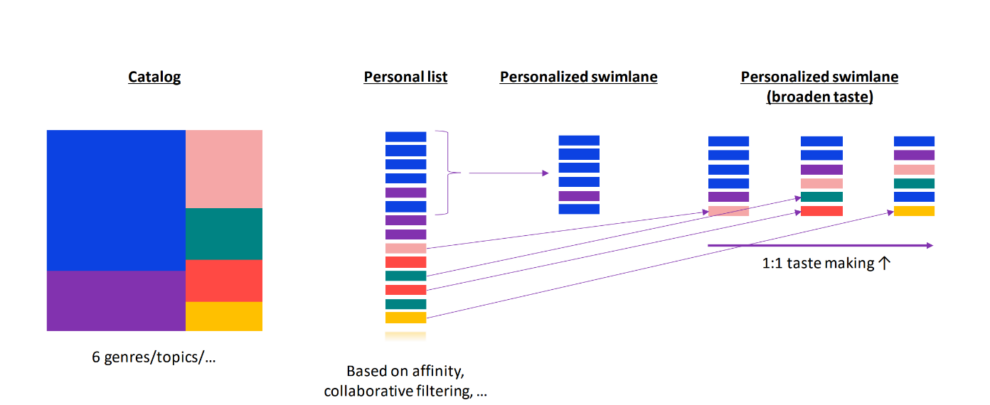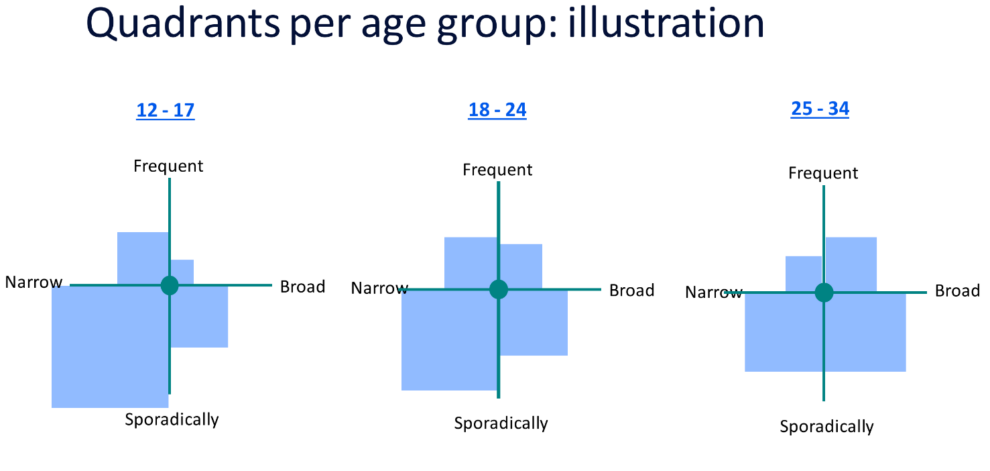Using Recommendation Algorithms to Broaden User Taste: VRT’s approach
How VRT challenges the traditional ways in which platforms use recommendation algorithms
In today’s attention economy, players in the digital media landscape compete for users’ time. Algorithms have become powerful tools for this purpose. Major platforms like YouTube, Netflix, and TikTok have refined their algorithms, often leveraging content-based filtering, to keep users hooked to their services. YouTube’s algorithm often prioritises sensational content, which may skew the informative balance. Netflix’s recommendation system’s primary goal is to keep users engaged with the platform (e.g., through auto-playing after an episode/movie finishes). Similarly, TikTok’s algorithm has been criticised for prioritising watch time over user safety, leading users towards harmful content despite its user preference detection.
In contrast, VRT (the national radio and TV broadcaster in Flanders, Belgium) is going against this trend by venturing into a taste-broadening algorithm without focusing on increasing the time users spend on the platform. Unlike the echo chambers often fostered by commercial social media algorithms, VRT aspires to diversify content exposure, nudging users to explore beyond their habitual preferences.
Emilie Nenquin, Head of Data & Intelligence at VRT, shed light on how VRT is using algorithms to do so at this year’s Twipe Digital Growth Summit, showcasing VRT’s intention to follow technological trends to keep content relevant and engaging.
💡The VRT is the national public-service broadcaster for the Flemish Community of Belgium
Objectives of VRT’s recommendation algorithm for content delivery
VRT Max, VRT’s online offering including livestream of VRT’s TV channels and video-on-demand, leverages user profiling and content-based filtering to tailor content delivery based on user interactions, moving beyond the conventional one-size-fits-all model.
The overarching goal of the algorithm is to expand users’ content tastes. In practice, this translates to exposing them to different genres of content that they might not have chosen for themselves, but that still captures their interest once served to them with the help of the algorithm. For example, a user who is mostly interested in football may get a recommendation for cycling content, testing whether they are going to interact with it.
That said, while VRT is motivating users to explore content beyond their usual taste preferences, they are conscious of the possibility of alienating their users by feeding content which is uninteresting to them. To avoid this, VRT strives to keeping user engagement levels constant by being mindful about how they introduce new genres, without overwhelming users.
As a public broadcaster, VRT has also adopted a high level of transparency towards their users. Stitchd, VRT’s digital analytics partner stated that “[nothing] happens without consent: users always need to agree before the platform can collect and process their data. To remain transparent, every algorithm is built in-house, so the VRT can always explain to their users which data they collect and why.”
How does VRT’s recommendation algorithm work?
VRT leverages metadata to understand and enhance user engagement. VRT obtains insights into reading and viewing habits across age groups by aggregating and analysing the content consumed. This metadata analysis provides a rich understanding of audience preferences and behaviours. The insights gained refine content strategies to cater to user preferences, delivering relevant content to them.
VRT’s content based recommendation system starts working from a “Catalogue” that encompasses the comprehensive content database of all genres that VRT has on offer. The algorithm then generates a “Personal List” from this extensive catalogue by shortlisting content based on individual user preferences, interests, and past interactions. Although this list remains broad, covering multiple genres, it reflects user affinity by varying the proportions of each genre.

This leads to the creation of the “Personalised Swimlane“, a curated content stream delivered directly to the user. At its inception, this stream closely resembles the aforementioned personal list, having been crafted using collaborative filtering—a method built on drawing parallels between the preferences of similar users.
As users continue on their content journey, the algorithm dynamically alters the “Personalised Swimlane” by introducing a richer diversity of content from the main catalogue, with the intention of gently directing users towards unexplored content territories. A significant component in this process is the “1:1 taste-making” step, ensuring that while users’ tastes expand, the presented content remains in line with their overarching preferences. Using techniques like content-based filtering, VRT’s algorithm effectively balances retaining user engagement while guiding them towards exploring different types of content. It provides a personalised experience that begins with the user’s current preferences and gradually introduces them to new genres.
Measuring the effectiveness of VRT’s algorithm
VRT measures the effectiveness of their algorithm using an “Activity vs. Taste” framework that categorises individuals based on their frequency of activity and the breadth of their tastes. For instance, the younger audience (12-17 years) predominantly shows sporadic activity with a narrower taste. As the age bracket increases, there’s a clear shift towards a broader taste, especially in the 25-34 age group.

The objective of this analysis is well-defined: to increase the average taste score of VRT users. The taste score is a metric that encapsulates the breadth of content genres a user interacts with. Over a period from September 2022 to May 2023, VRT has measured the evolution of the taste score, tracking the impact of its algorithmic strategies on user engagement and content diversity. The upward trajectory in the average taste score is a testament to the success of VRT’s algorithm in nudging users towards a diverse content palette, aligning with the mission of informing and inspiring the audience.
Finding new avenues to engage with younger audiences
Recognising that younger generations utilise different news sources, VRT is committed to finding alternative ways to engage with them. According to the Reuters Institute Digital News Report 2023, 30% of people use social media as their main news source. To capitalise on this growing trend, VRT has created a dedicated Instagram account, nws.nws.nws. It aims to foster an open dialogue space where teens feel heard and involved. What sparked this series of initiatives was a new approach to VRT’s programme ‘Karrewiet’, which delivered tailor-made news and resonated well with young audiences. Despite challenges like differing content consumption dynamics on social media, VRT’s endeavours like nws.nws.nws and Karrewiet showcase its active involvement in ensuring a meaningful user experience for the younger demographic.
VRT elevates community building beyond traditional news sharing. For instance, it actively interacts with users in the comment sections of its Instagram page nws.nws.nws and offers weekly schoolroom visits to discuss the news, where their younger audience is. These initiatives bring news closer and facilitate a two-way dialogue, enhancing understanding and engagement with the youth. Additionally, quizzes on famous personalities add a fun, engaging layer to news consumption, encouraging youth to delve into serious topics. These initiatives mirror similar efforts run by Le Monde to engage younger audiences.
Key Takeaways
The journey of VRT in redefining user engagement encapsulates several key learnings and takeaways:
- Taste-Broadening Algorithm: Unlike major platforms prioritising watch time and user retention, VRT focuses on a taste-broadening algorithm. Their main goal is to expose users to various content genres, expanding their content tastes beyond habitual preferences.
- User Profiling and Personalisation: VRT uses user profiling to customise content delivery. They employ a recommendation algorithm that crafts a “Personalised Swimlane” for users, which starts with content closely aligned to user preferences but gradually introduces them to different genres.
- Transparency and Consent: VRT emphasises transparency and user consent. They build all algorithms in-house, which allows them to clearly explain to their users the kind of data being collected and the reasons for doing so. Before collecting any data, they ensure users give their consent.
- Activity vs. Taste Measurement: VRT tracks the effectiveness of their recommendation algorithm using an “Activity vs. Taste” framework. Their tracking has shown that VRT’s algorithms are effectively broadening users’ tastes.
- Engaging Younger Audiences: Recognising the evolving content consumption habits of younger generations, VRT has initiated platforms like the dedicated Instagram account nws.nws.nws. These platforms aim to deliver news in a way that resonates with young audiences, fostering dialogue and engagement.
VRT’s approach to digital broadcasting is a great example of how algorithms can be used to engage audiences. Combining data-driven strategies with a human-centric approach, VRT stays true to its cause. By understanding what audiences want and personalising content, VRT builds communities and keeps viewers informed, inspired, and engaged. VRT’s approach is a reminder of how powerful algorithms can be when used thoughtfully.
Other Blog Posts

Stay on top of the game
Join our community of industry leaders. Get insights, best practices, case studies, and access to our events.
"(Required)" indicates required fields

